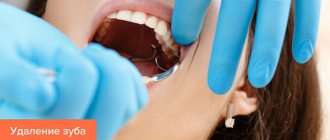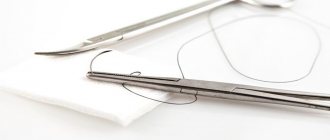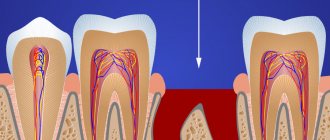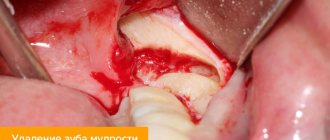The wisdom tooth is one of the most difficult teeth to treat and remove. The reasons lie in the unpredictability of this tooth, namely: the number of roots, canals, their shape, the tooth is often not fully erupted, covered with a mucous membrane, sometimes even with bone. Also, all manipulations with this tooth are complicated by its localization and very limited access. In addition, many patients experience problems with wide mouth opening.
All this makes the removal process very difficult and traumatic, so after removing a wisdom tooth, a swollen cheek and pain are normal, and you should not be afraid of them. To help your body cope with symptoms and speed up healing, you need to follow your doctor's orders and follow simple symptoms management tips.
Situations in which swelling is not a cause for concern
In many cases, swelling that occurs after tooth extraction is normal and should not cause alarm.
There is no need to worry if:
- The swelling is mild and does not increase over time. If tooth extraction turned out to be traumatic or was carried out against the background of severe inflammation, then slight swelling is allowed to appear, which should go away on its own in a couple of days.
- Body temperature is slightly elevated, but does not increase over time, or is completely within acceptable values. Removing a tooth when it is inflamed can cause a slight increase in temperature, which, if the source of pain has been eliminated, quickly subsides.
- There is no increasing pain. A sign of normality is the presence of slight pain (after all, removal is a surgical procedure during which soft tissues are injured), gradually decreasing over time. If the pain does not go away, or its strength increases, then this indicates either increasing inflammation or the occurrence of any complications.
- The hole left after the operation is closed with a blood clot. Naturally, after the procedure, the hole is filled with rapidly clotting blood. This clot reliably protects the tissue, preventing the development of an inflammatory process.
After removal, the cheek may look swollen for one day - this is a period during which you should not worry. If after 24 hours there is no obvious deterioration and the swelling decreases, there is no need to waste time on a visit to the dentist. But if at least one of the symptoms listed above is present, this indicates the need to make an appointment with a dentist as quickly as possible in order to prevent the situation from worsening.
How to eliminate cheek swelling
It is impossible to completely remove the tumor until the inflammatory process stops, but you can reduce it and minimize discomfort and pain. This can be done with ice and cold compresses. You need to apply a compress every half hour, but no longer than 10-15 minutes, otherwise it can cause hypothermia and tissue necrosis.
In addition, you can drink painkillers, analgesics, take baths and rinses with an antiseptic solution. Take antibiotics if prescribed by your doctor. This will eliminate the infection and speed up tissue healing.
In general, swelling of the cheek is a normal phenomenon if it occurs a couple of hours after tooth extraction and goes away no later than the seventh day after it. In all other cases, immediate specialist consultation, diagnosis and treatment are required.
When you can't do without a doctor's help
If any of the situations listed below arise, you need to go to the dentist, who will take the necessary measures (wash the hole, put in medicine, take measures to release pus, etc.).
So, you can’t do without a trip to the dental clinic if:
- The swelling that appears after removal does not subside, but, on the contrary, grows. In this case, there is no point in continuing to wait, since it is obvious that the situation will not resolve itself. Swelling may indicate inflammation or suppuration. In some cases, swelling can develop to large sizes, affecting the area under the eye.
- There is pain that does not decrease over time. Severe pain for a couple of days is acceptable only with a particularly difficult removal, accompanied by sawing out the bone: in all other situations, the pain should decrease and completely disappear after 1-2 days.
- The temperature rises.
- Feeling unwell does not go away.
- There are difficulties opening the mouth and making swallowing movements.
- There is no blood clot in the hole left after tooth extraction. Perhaps the clot simply fell out or was washed out when rinsing the mouth. If there is no clot, then the risk of inflammation increases, which is accompanied by very severe pain. It is useless to wait patiently for the pain to go away on its own: the dentist, having assessed the situation, will administer the required medicine, which will quickly relieve the discomfort.
Sometimes swelling does not appear immediately, but 3-4 days after surgery. Typically this is due to the fact that:
- the blood clot in the socket has festered;
- inflammation began in the hole.
This condition is called alveolitis. With this inflammatory lesion, self-medication using antibiotics and other medications is pointless. Only a doctor can alleviate the patient’s condition by clearing the hole of small food debris and placing medicine inside.
Sometimes a hematoma may form on the gum. In the first few days after its appearance, it may not cause attacks of pain or lead to swelling of the cheek, however, when obvious signs of suppuration are visible, leading to pain, you should consult a dentist, who will most likely open the hematoma.
In what cases is medical assistance needed?
Symptoms of the postoperative period should alert you in the following cases:
- with redness of the mucous membrane and skin, shortness of breath (signs of tachycardia);
- if a rash has formed on the upper body (allergy to drugs);
- when the tumor increases, it appears on other parts of the gum or on the entire side of the face;
- when your health worsens (fever, difficulty swallowing saliva, opening your mouth, painful chewing);
- progressive pain;
- if a putrid odor begins to emanate from the mouth;
- when the swelling went away after the operation, and after some time began to grow again;
- swelling lasts too long.
Each option may indicate an ongoing complication, so there is no point in wasting time postponing a visit to the doctor.
When should swelling occur?
There are situations when the development of noticeable edema is inevitable. They arise:
- After an operation of increased complexity. Removal accompanied by damage to nearby tissues (for example, when it is necessary to saw out bone or incisions in the mucous membrane) leads to the appearance of edema. In some situations (for example, when the eighth tooth is removed), facial asymmetry is likely to occur.
- When removed due to severe inflammation. Then an infection remains in the hole, which can become the main cause of swelling. If the operation is carried out in compliance with all the rules, then the dentist, seeing inflammation, is obliged to thoroughly rinse the wound with an antiseptic solution, and then apply the medicine. Sometimes antibiotics are prescribed. However, even then it cannot be said that the inflammatory process will not begin.
- When cutting the gums on which there is an abscess, the dentist makes an incision to release the pus located in the soft tissues. If there was already a slight swelling during the procedure, it may increase slightly in size, which is normal.
- When contacting people suffering from certain diseases. Quite often, according to the observations of dentists, patients who have high blood pressure complain about swelling of the cheek after tooth extraction, leading to the accumulation of a subcutaneous fat layer on the face. In such people, swelling may well appear even with normal removal, which proceeds without any complications.
Causes of flux after extraction
In dentistry, gumboil refers to an inflammatory process that forms inside soft tissues and manifests itself in the form of swelling, purulent discharge, fever and other unpleasant syndromes. The medical term is periostitis. There is only one mechanism for the development of flux: pathogenic bacteria provoke the development of infection, which penetrates into the gums and periosteum through microtubules.
Dangerous symptoms!
- Deep inflammatory process.
- Invasive tooth extraction, after which the gums are injured. If additional anti-inflammatory therapy is not given, infection may develop.
- Poor-quality temporary prosthesis, which caused gum injury and infection.
- Dry socket syndrome.
How to get rid of swelling at home
If there is no reason to see a doctor, but you want to get rid of the swelling as soon as possible, you can try the following methods:
- Immediately after removal or surgery, apply a cold compress (water bottle, wet cloth). The application must be repeated throughout the day once every half hour for 5 minutes. ATTENTION! Using a cold compress on the second, third, etc. day is unacceptable.
- Use special decongestant ointments.
- Sleep with your pillow raised high.
- After a few days, cold compresses are replaced with warm ones. A single session of the procedure should not exceed half an hour. Vasodilation and increased blood flow promote faster recovery.
- use corticosteroids. Since this type of drug has many side effects, it is better to consult a doctor before taking it. You should resort to these medications only in cases of extreme necessity, when pain due to swelling interferes with normal daily activities.
- These methods should be used if there are no complications: in other cases, it is recommended to consult a doctor for a detailed examination.
After 2–3 months and beyond
The gum gradually hardens, and the space remaining from the tooth is filled with maturing bone tissue. By the beginning of the 4th month, the gum bone tissue completes its formation. The gum can be called completely healed.
If the wound heals with suppuration, then healing of the wound can last up to six months.
Complications of edema and methods of dealing with them
Often, swelling is accompanied by one or more complications from the list below:
- bleeding. A little bleeding is normal. If there is more blood, the wound can be pressed with a gauze pad moistened with an antiseptic (for example, Chlorhexidine). If bleeding does not go away for more than 2 days, you should not delay visiting a doctor;
- numbness. After any dental procedure, the area around the mouth may lose sensation. There is nothing wrong with this if the side effect goes away within 12 hours;
- the occurrence of pain, which is acceptable even after surgery. The main rule is that pain should decrease within a couple of days. In some cases, the pain can be so severe that a person cannot chew food (the condition should last no more than 5 days). To alleviate this condition, you can take painkillers (for example, paracetamol);
- the occurrence of a dry socket after surgery (especially important for smokers). In this case, a blood clot, without which the healing process is impossible, does not form. The condition is often accompanied by a feeling of pain and an unpleasant taste in the mouth. The most effective way to combat it is to wash the wound several times a day, followed by applying an antiseptic bandage.
Day after the procedure
At the initial stage, the hole remaining in the place of the pulled out tooth is filled with a scarlet blood clot. It is not recommended to remove it, as it performs several functions:
- protects the wound from infections;
- eliminates bleeding from blood vessels;
- promotes the formation of new tissue that will fill the empty space.
To avoid breaking up the blood clot, it is recommended not to brush your teeth on the day of surgery. Smoking is accompanied by inhalation of smoke, which creates negative pressure in the oral cavity. This may help pull the clot out of the socket. It is not recommended to blow your nose or spit. Rinsing your mouth should also be avoided; you can simply put the solution in your mouth and hold it for a while without rinsing. Gentle rinsing can be indicated only in the presence of inflammatory and purulent processes.
Diseases that occur after tooth extraction and cause swelling
When teeth are removed (in particular, molars, canines and incisors), the following diseases may occur:
- alveolitis, when suppuration of the hole occurs. Accompanied by swelling of the cheeks and cheekbones. The temperature rises, general weakness occurs, and bad breath appears;
- osteomyelitis is a disease in which the jaw bone becomes inflamed (the process is accompanied by the formation of pus). The cheek swells at the site of inflammation, and the pain affects the entire row of teeth. It becomes painful for a person to open his mouth and talk. The disease is accompanied by severe headache and fever; in some cases, blood poisoning is possible (if you do not consult a doctor in time);
- neuritis. The facial nerve is affected, which is accompanied by acute pain. Quite often it occurs when teeth with long roots are removed. With neuritis, the cheek becomes swollen and numb; numbness also affects the palate, larynx and tongue.
Indications for removal of eighth teeth
wisdom teeth
begin to grow much later than other permanent teeth, as a result of which they often do not have enough space in the jaw. Lack of space provokes all sorts of curvature of roots and crowns. Doctors advise removing such molars. Here is another list of problems that may require extraction:
- A pronounced tilt of the figure eight towards the seventh tooth or cheek.
- Hypercementosis (excessive deposition of secondary cement, in which the tooth root thickens and becomes deformed).
- Incomplete eruption of the tooth or its location in the bone (retention).
- Destruction of the crown or roots of the figure eight, as well as neighboring teeth (after injury or caries).
- Granuloma (granulation in the form of cystic sacs with pus located in the periodontium).
- Rotation of the tooth around its axis or horizontal position (dystopia).
- Deformation of the roots (they can bend in every possible way, even twist into a spiral or form an angle of 90°).
- The close location of the roots of the upper eights to the nasal maxillary sinuses.
- In the presence of pericoronitis (an acute inflammatory process in the area of the eruption of the figure eight, accompanied by pain and an increase in ESR in blood tests).
An incorrectly growing 8th tooth can compress the facial nerves and provoke neuritis, which is expressed by sharp pain radiating to the ears, neck, temple, and can lead to facial paralysis.
How to prevent complications?
To avoid swelling and subsequent treatment, it is recommended:
- Keep your head held high for at least 12 hours after surgery (or better yet, 24 hours). To do this, while lying down, you need to place several pillows under your head;
- do not touch the hole with your tongue or fingers;
- do not use warm compresses for 36 hours after surgery;
- do not smoke or drink alcohol for 72 hours after surgery.
Correct behavior after surgery is no less important than the procedure itself: if you adhere to the above rules, the swelling will go away either in the shortest possible time or will not occur at all.
Preventive measures
Since the likelihood of swelling after tooth extraction is quite high, the following recommendations should be followed to minimize the risk of cheek swelling (the same rules apply in cases where swelling has already formed and needs to be removed as soon as possible):
- use oral baths (the salt liquid is only kept in the mouth without rinsing, since otherwise infection of the hole may occur);
- use anesthetics to relieve pain. As a rule, these are Ketanov, Ibuprofen and other similar drugs that reduce the inflammatory process and relieve pain. The most important thing is to follow the dosage indicated in the instructions;
- follow the diet. If an operation has been performed, then on the first day you should not eat hard or hot food, as it can cause injury to the already damaged gum. During the week after surgery, the basis of the diet should be soft and non-spicy foods. Until the swelling goes away, it is better to chew on the other side of the mouth, doing it slowly;
- Avoid taking hot baths, as this may cause bleeding from the socket;
- When brushing your teeth, skip the operated area until the swelling goes away.
- On average, swelling subsides within 2-3 days from the date of surgery: if this does not happen, you will have to contact the dentist again for an examination and additional research if necessary.
Folk remedies
Let's look at useful rinse recipes that are used to treat gingivitis and alveolitis after tooth extraction.
One tablespoon of dry crushed chamomile (sage, calendula) should be steamed with 250 ml of boiling water. The mixture should be left for an hour, wrapped in a towel, then filtered and used for rinsing. It is recommended to rinse your mouth every 2-3 hours.
The following healing recipes will help relieve inflammation and relieve discomfort:
- Mix 20 drops each of tea tree oil, cloves and liquid vitamins A and E, add a pinch of cayenne pepper. Moisten a cotton swab with the resulting medicine and apply it to the painful area.
- Wet baking soda with water to form a paste and apply it to the inflamed area.
ASEPTA gel with propolis will help you quickly cope with gum inflammation. This unique product containing the waste product of bees relieves inflammation of the gums by 31%, has anti-inflammatory, antimicrobial effects against gram-positive bacteria, as well as antipruritic and analgesic effects (reduces the pain of affected tissues), accelerates the process of regeneration and epithelization of wound surfaces, stimulates metabolic processes.
We hope that our recommendations for the treatment of gum inflammation after tooth extraction will be for informational purposes only. Treat yourself carefully and remember: at the first symptoms - acute pain in the gums, sudden changes in temperature, severe swelling of the gums, discharge of purulent exudate - consult a doctor as soon as possible. A lesion can be disastrous, so take care of yourself after surgery.
Sources:
- Clinical and laboratory assessment of the influence of domestic therapeutic and prophylactic toothpaste based on plant extracts on the condition of the oral cavity in patients with simple marginal gingivitis. Doctor of Medical Sciences, Professor Elovikova T.M.1, Candidate of Chemical Sciences, Associate Professor Ermishina E.Yu. 2, Doctor of Technical Sciences Associate Professor Belokonova N.A. 2 Department of Therapeutic Dentistry USMU1, Department of General Chemistry USMU2
- Clinical studies of antisensitive toothpaste “Asepta Sensitive” (A.A. Leontyev, O.V. Kalinina, S.B. Ulitovsky) A.A. LEONTIEV, dentist O.V. KALININA, dentist S.B. ULITOVSKY, Doctor of Medical Sciences, Prof. Department of Therapeutic Dentistry, St. Petersburg State Medical University named after. acad. I.P. Pavlova
- Comparative clinical evaluation of the effectiveness of treatment of traumatic lesions of the oral mucosa IORDANISHVILI A.K. *,** Doctor of Medical Sciences, Professor, Professor of the Department *Department of Orthopedic Dentistry of the Federal State Budgetary Educational Institution of Higher Education “North-Western State Medical University named after. I.I. Mechnikov" of the Ministry of Health of the Russian Federation (rector - Doctor of Medical Sciences Sayganov S.A.); **Department of Maxillofacial Surgery and Surgical Dentistry of the Federal State Budgetary Military Educational Institution of Higher Education “Military Medical Academy named after S.M. Kirov" of the Ministry of Defense of the Russian Federation (chief - Corresponding Member of the Russian Academy of Sciences, Professor A.Ya. Fisun).
- The role of anti-inflammatory rinse in the treatment of periodontal diseases (L.Yu. Orekhova, A.A. Leontyev, S.B. Ulitovsky) L.Yu. OREKHOVA, Doctor of Medical Sciences, Prof., Head of Department; A.A. LEONTIEV, dentist; S.B. ULITOVSKY, Doctor of Medical Sciences, Prof. Department of Therapeutic Dentistry of St. Petersburg State Medical University named after. acad. I. P. Pavlova
- Report on clinical trials of anti-inflammatory balm for gums "Asepta" adhesive, St. Petersburg State Medical University, 2007
- Report on determining/confirming the preventive properties of commercially produced personal oral hygiene products: Asepta toothpaste used in combination with Asepta mouthwash and Asepta gum balm Head. Department of PFS Doctor of Medical Sciences Professor S.B. Ulitovsky St. Petersburg State Medical University named after Academician I.P. Pavlova. Faculty of Dentistry. Department of Preventive Dentistry.











